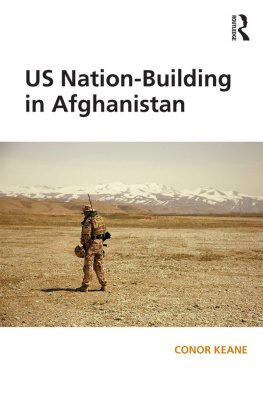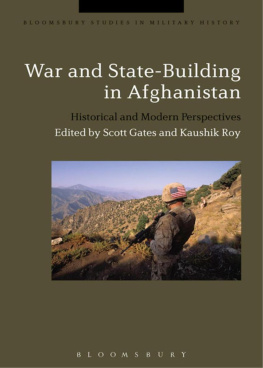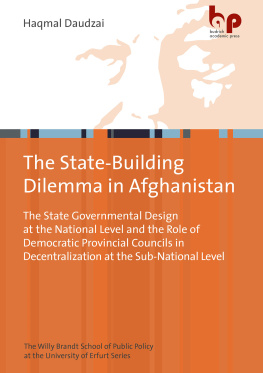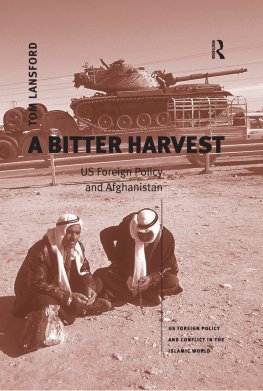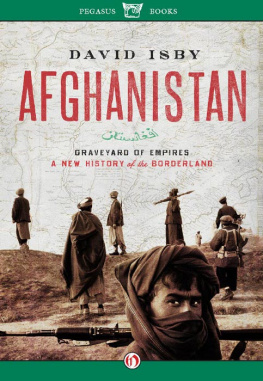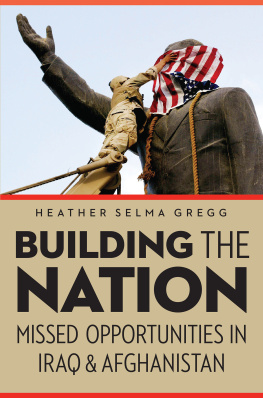US Nation-Building in Afghanistan
Why has the US so dramatically failed in Afghanistan since 2001? Dominant explanations have ignored the bureaucratic divisions and personality conflicts inside the US state. This book rectifies this weakness in commentary on Afghanistan by exploring the significant role of these divisions in the USs difficulties in the country that meant the battle was virtually lost before it even began. The main objective of the book is to deepen readers understanding of the impact of bureaucratic politics on nation-building in Afghanistan, focusing primarily on the Bush administration. It rejects the rational actor model, according to which the US functions as a coherent, monolithic agent. Instead, internal divisions within the foreign policy bureaucracy are explored, to build up a picture of the internal tensions and contradictions that bedevilled US nation-building efforts. The book also contributes to the vexed issue of whether or not the US should engage in nation-building at all, and if so under what conditions.
Dr Conor Keane has degrees in law and politics, and a doctorate on nation-building in Afghanistan from Macquarie University. His research interests include counter terrorism, state building, bureaucratic politics and US foreign policy. He has published several articles on these topics in journals such as Armed Forces & Society and International Peacekeeping.
US Nation-Building in Afghanistan
Conor Keane

First published 2016
by Routledge
2 Park Square, Milton Park, Abingdon, Oxon OX14 4RN
and by Routledge
711 Third Avenue, New York, NY 10017
Routledge is an imprint of the Taylor & Francis Group, an informa business
2016 Conor Keane
The right of Conor Keane to be identified as author of this work has been asserted by him in accordance with sections 77 and 78 of the Copyright, Designs and Patents Act 1988.
The Open Access version of this book, available at www.taylorfrancis.com, has been made available under a Creative Commons Attribution-Non Commercial-No Derivatives 4.0 license.
Trademark notice: Product or corporate names may be trademarks or registered trademarks, and are used only for identification and explanation without intent to infringe.
British Library Cataloguing in Publication Data
A catalogue record for this book is available from the British Library
Library of Congress Cataloging-in-Publication Data
Names: Keane, Conor.
Title: US nation building in Afghanistan / by Conor Keane.
Other titles: United States nation building in Afghanistan
Description: Farnham, Surrey, UK; Burlington, VT: Ashgate, 2016. |
Includes bibliographical references and index.
Identifiers: LCCN 2015030413 | ISBN 9781472474841 (hardback: alk.
paper) | ISBN 9781472474858 (ebook) | ISBN 9781472474865 (epub)
Subjects: LCSH: Nation-buildingAfghanistan. | Postwar reconstruction
Afghanistan. | Postwar reconstructionGovernment policy
United States. | United StatesForeign relationsDecision making. |
United StatesForeign relationsAfghanistan. | AfghanistanForeign
relationsUnited States.
Classification: LCC DS371.4 .K397 2016 | DDC 958.104/72dc23
LC record available at http://lccn.loc.gov/2015030413
ISBN: 9781472474841 (hbk)
ISBN: 9781315548623 (ebk)
Typeset in Times New Roman
by Apex CoVantage, LLC
Contents
Part I
Background and Methodology
Part II
US Nation-Building in Afghanistan
Part III
Avenues for Inter-Agency Cooperation
In the course of researching and writing this book I have received assistance from a number of parties. Professionally, I owe the most significant debt to Dr Lloyd Cox. I would also like to acknowledge Dr Ashley Lavelle, Dr Steve Wood and Associate Professor Morris Morley for taking the time to look at my chapters and offer advice and encouragement. I extend my gratitude to the senior US officials who were willing to permit me to interview them at length. The insights they provided were invaluable.
Personally, I would like to express my gratitude to my brother, for his empathy, and my father, for his unfailing patience and understanding. But most of all I would like to thank my mother, who since I began undergraduate studies has been an ever-willing listener and proofreader. She has pushed me beyond boundaries of self-doubt that I surely would not have conquered otherwise.
Mum, I dedicate this book to you.
On 11 September 2001 an event occurred that impacted significantly on the shape and nature of US foreign policy. The destruction of the World Trade Center, damage to the Pentagon, and the deaths of almost 3,000 US citizens, could not go unanswered. An overwhelming majority of a stunned US population looked to the government and military for retribution. In this heated political climate, President George W. Bush declared a Global War on Terror (GWOT), a protracted conflict against an insubstantial enemy. Richard Myers, the Chairman of the Joint-Chiefs of Staff, described it as a different kind of conflict unlike any other in recent American history. This would be a conflict without temporal and spatial horizons, where non-state, terrorist actors were as much a target of US military action as the states that harboured them.
Barely a month after 9/11, the first battleground in the GWOT became Afghanistan. Here the Taliban government was sheltering Al Qaeda, the fundamentalist, Islamic terrorist group responsible for the attacks. Bush called for the Taliban to hand over Al Qaedas leader, Osama Bin Laden, and their refusal to do so precipitated a US invasion. Rallying under the banner of national self-defence, the organs of the US government swiftly mobilized for a military strike aimed at regime change. Following a resounding military victory, however, the ties that bound the foreign policy machine together began to fray, as the realities of the political and military situation unfolded over the coming months and years.
As the Taliban regime crumbled in the face of American military might, some educated Afghans and many more Americans hoped that a stable and representative government could replace it. But a smooth transition to Western-style democracy was always an unlikely, if not altogether utopian, challenge, given Afghanistans economic underdevelopment, ethno-sectarian fissures, and institutional fragility born of decades of military conflict and authoritarian rule. From 2001 to 2003, the scale and complexity of this challenge was not something the Bush Administration seriously considered. On the one hand, the abstracted rhetoric of long-term political goals and ambitions envisaged the cultivation of a stable, pluralistic and representative Afghan government. On the other hand, the human and material resources on which such an outcome would be premised were never forthcoming. Consequently, US insouciance in the years immediately after the invasion, thinly disguised beneath the euphemistic language of having a light footprint, contributed to the rise of a ferocious and destabilizing insurgency. This heralded the return of the Taliban as a significant political force. As the insurgency intensified, policymakers reappraised the situation and emphasized the need for a comprehensive, whole-of-government approach.
Despite some limited progress, a refurbished, whole-of-government approach to Afghanistans problems fell far short of its objectives. By 2008, a quarter of Afghanistans population still did not have access to clean water, and 50 per cent of Afghan children were malnourished. Over six million people required food aid, including approximately 172,000 teachers who were not able to support themselves. When the majority of US officials and soldiers withdrew from the country in 2014, they left a volatile and fragmented political environment in their wake, much as the British and Soviets had done before them. This was despite more than a decade of US nation-building efforts in Afghanistan.

